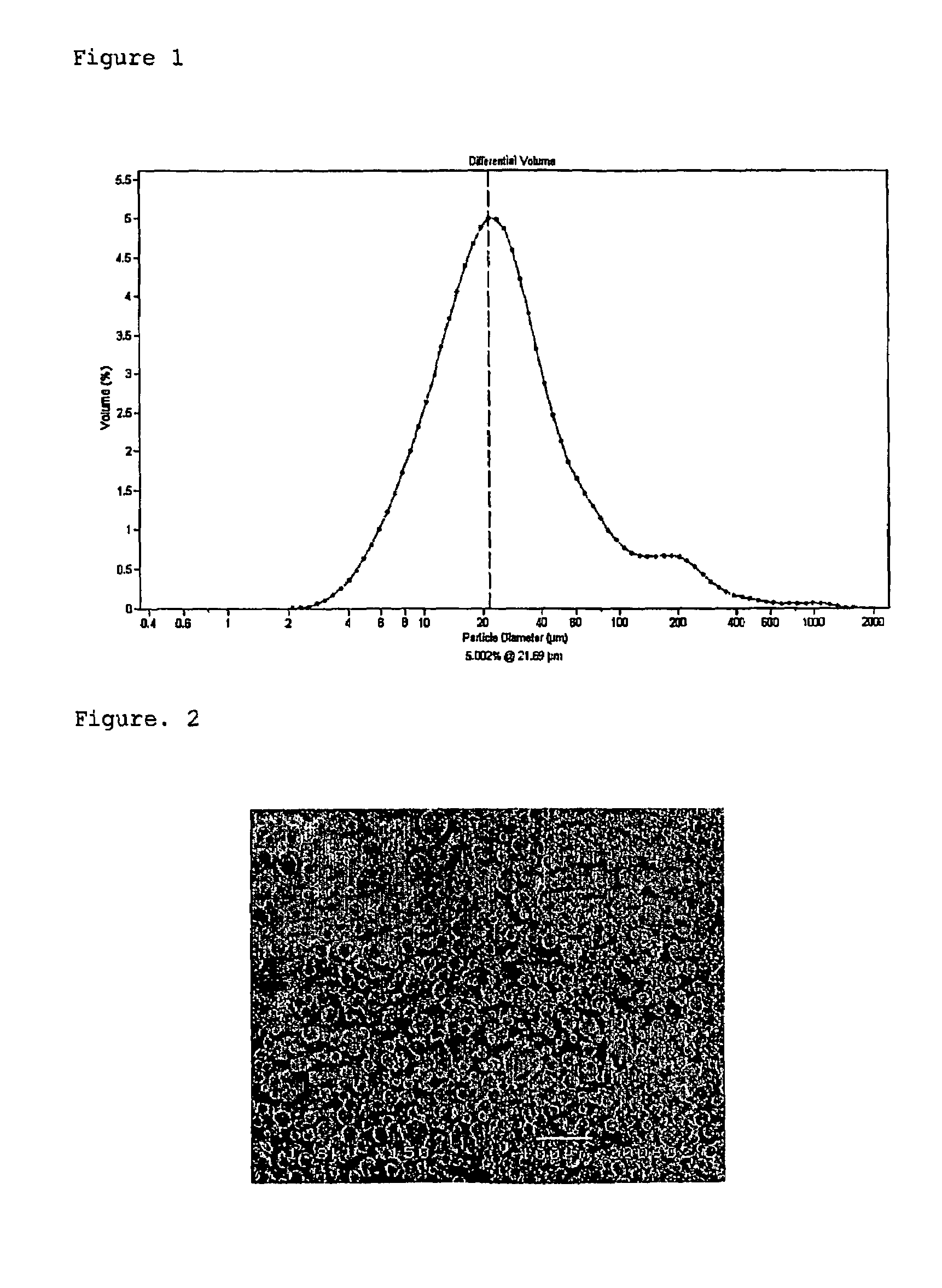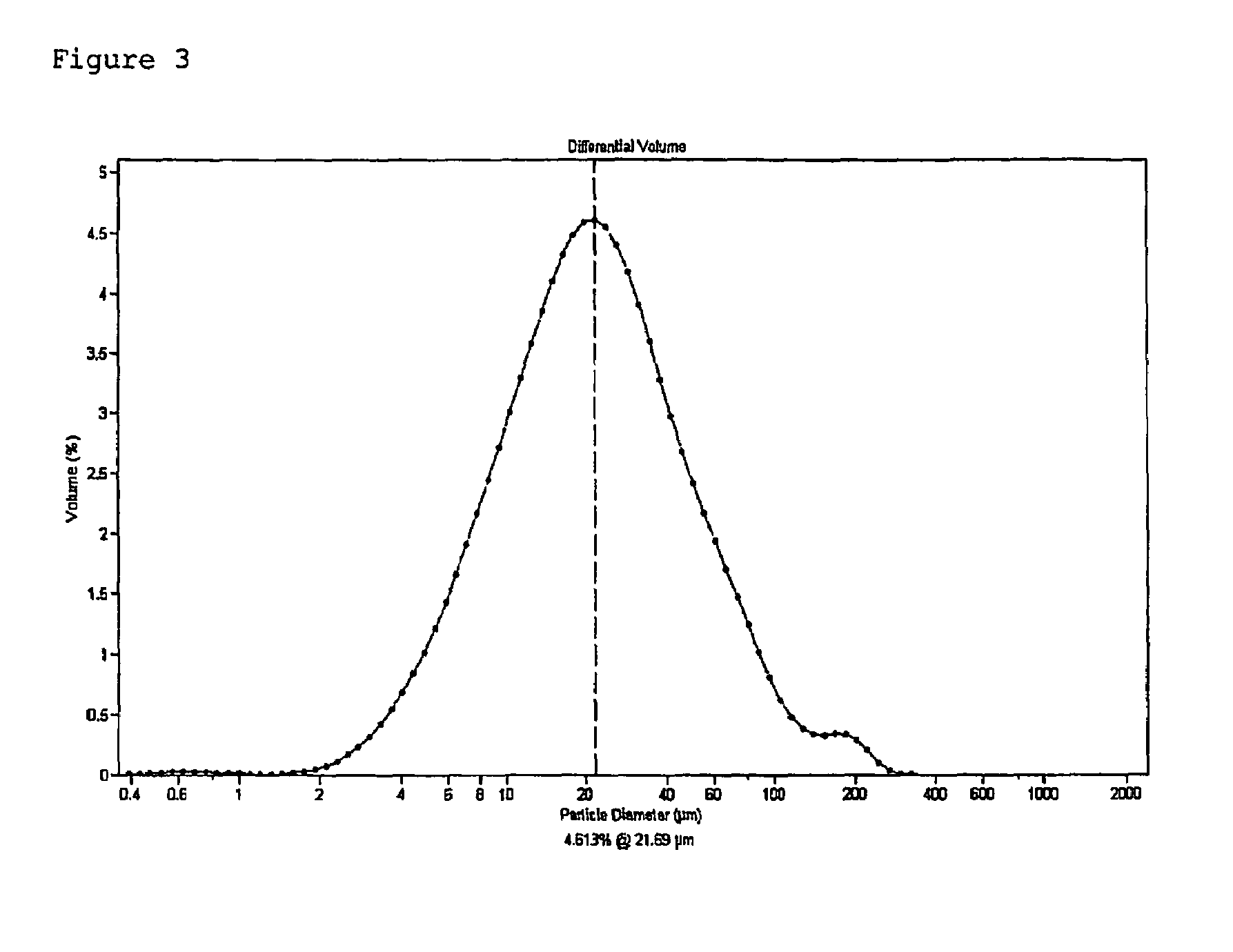Production of olefin polymerization catalysts
a technology of olefin polymerization and catalyst, which is applied in the direction of catalyst activation/preparation, organic compound/hydride/coordination complex catalyst, chemical/physical process, etc., can solve the problem of polymer fluff formation, poor morphology of polymer thus produced, and fouling of the reactor
- Summary
- Abstract
- Description
- Claims
- Application Information
AI Technical Summary
Benefits of technology
Problems solved by technology
Method used
Image
Examples
example 1
Complex Preparation
[0123]49.3 mg of bis(n-butyl-cyclopentadienyl)zirconium dichloride (Eurocen 5031, Witco GmbH) were reacted with 4 ml MAO solution, 30 wt-% in toluene (Albemarle) under stirring at room temperature in a septa bottle for 30 minutes. A yellow solution of activated complex (with target Al / Zr=200) was obtained.
Surfactant Preparation
[0124]284 mg of 2,2,3,3,4,4,5,5,6,6,7,7-dodecafluoroheptanol (Apollo Scientific, UK) were added slowly to 0.5 ml MAO under stirring. A heavy reaction with liberation of gas occours. Afterwards, additional 0.5 ml of MAO were added to the solution. No visible reaction was observed.
Emulsion Formation
[0125]20 ml of dried perfluorooctane (98%, P & M Invest, Moscow, Russia) were bubbled with nitrogen for 15 minutes (to remove oxygen traces) and filled into a 50 ml glass reactor with four baffles and an anchor-type stirrer. The above-mentioned activated complex solution and the above-mentioned surfactant were added successively. A liquid-liquid two...
example 2
Complex Preparation
[0132]40.8 mg of bis(n-butylcyclopentadienyl)zirconium dichloride (Eurocen 5031, Witco GmbH) was reacted with 4 ml MAO (30 wt-% in toluene, Albemarle) under stirring at room temperature in a septabottle for 30 minutes. A yellow solution of activated complex (with target Al / Zr=200) was obtained.
Surfactant Preparation
[0133]195 mg of 2,2,3,3,4,4,5,5,6,6,7,7,8,8,9,9,9-heptadecafluoro-1-nonanol (Apollo Scientific, UK) was added slowly to 0.5 ml MAO under stirring. A heavy reaction with liberation of gas occurred. Afterwards, additional 0.5 ml of MAO was added to the solution. No visible reaction was observed.
Emulsion Formation
[0134]20 ml of dried perfluorooctane (98%, P & M Invest, Moscow, Russia) was bubbled with nitrogen for 15 minutes (to remove oxygen traces) and filled into 50 ml glass reactor with four baffles and an anchor-type stirrer. The above-mentioned activated complex solution and the above-mentioned surfactant are added successively. A liquid-liquid two-p...
example 3
Complex Preparation
[0137]42.9 mg of bis(n-butylcyclopentadienyl)zirconium dichloride (Eurocen 5031, Witco GmbH) was reacted with 4 ml MAO (30 wt-% in toluene, Albemarle) under stirring at room temperature in a septabottle for 30 minutes. A yellow solution of activated complex (with target Al / Zr=200) was obtained.
Surfactant Preparation
[0138]168 mg of 2,2,3,3,4,4,5,5,6,6,7,7-dodecafluoroheptanol (Apollo Scientific, UK) was added slowly to 0.5 ml MAO under stirring. A heavy reaction with liberation of gas occurred. Afterwards, additional 0.5 ml of MAO was added to the solution. No visible reaction was observed.
Emulsion Formation
[0139]20 ml of dried perfluorooctane (98%, P & M Invest, Moscow, Russia) was bubbled with nitrogen for 15 minutes (to remove oxygen traces) and filled into 50 ml glass reactor with four baffles and an anchor-type stirrer. The above-mentioned activated complex solution and the above-mentioned surfactant are added successively. A liquid-liquid two-phase system is ...
PUM
| Property | Measurement | Unit |
|---|---|---|
| temperature | aaaaa | aaaaa |
| temperature | aaaaa | aaaaa |
| size | aaaaa | aaaaa |
Abstract
Description
Claims
Application Information
 Login to View More
Login to View More - R&D
- Intellectual Property
- Life Sciences
- Materials
- Tech Scout
- Unparalleled Data Quality
- Higher Quality Content
- 60% Fewer Hallucinations
Browse by: Latest US Patents, China's latest patents, Technical Efficacy Thesaurus, Application Domain, Technology Topic, Popular Technical Reports.
© 2025 PatSnap. All rights reserved.Legal|Privacy policy|Modern Slavery Act Transparency Statement|Sitemap|About US| Contact US: help@patsnap.com


